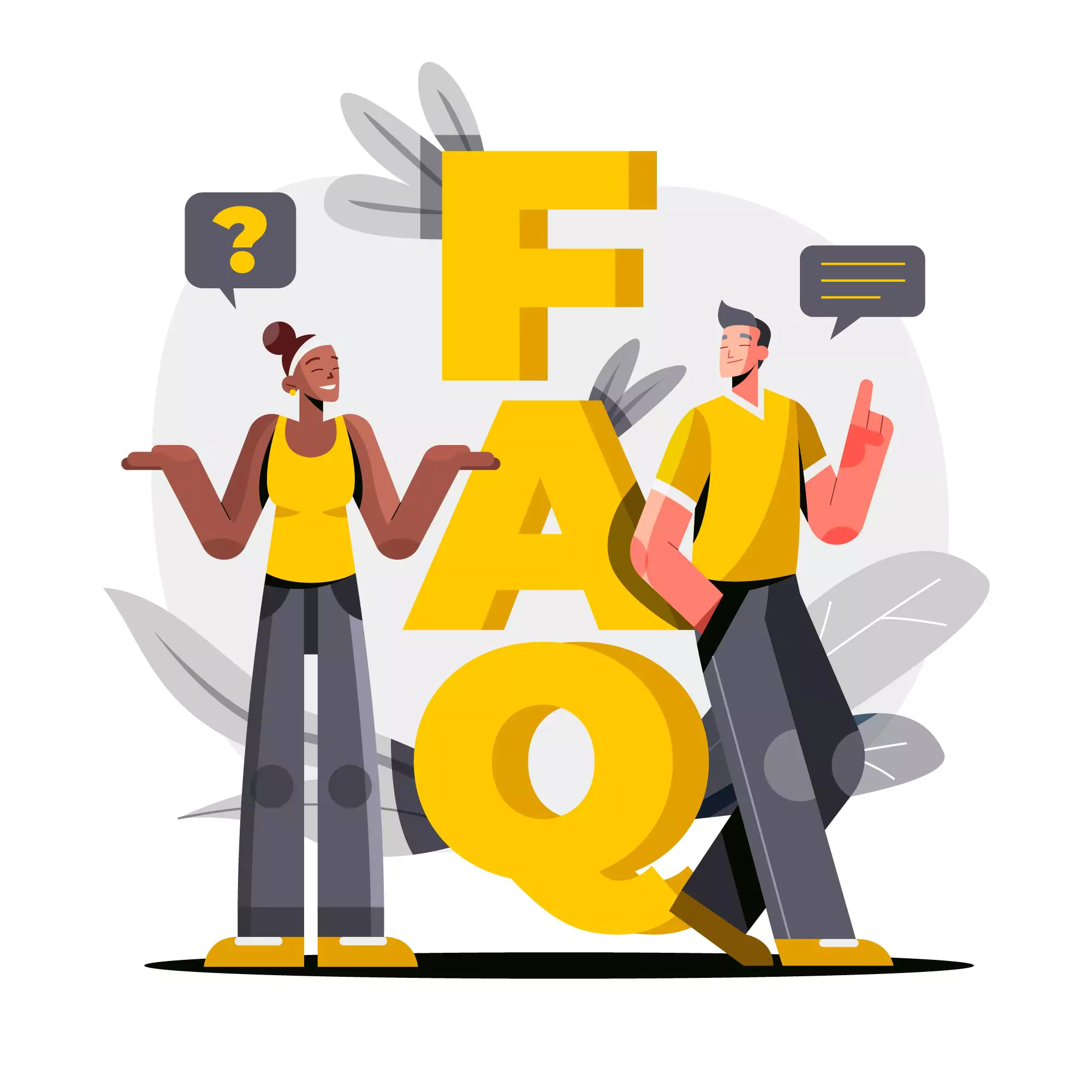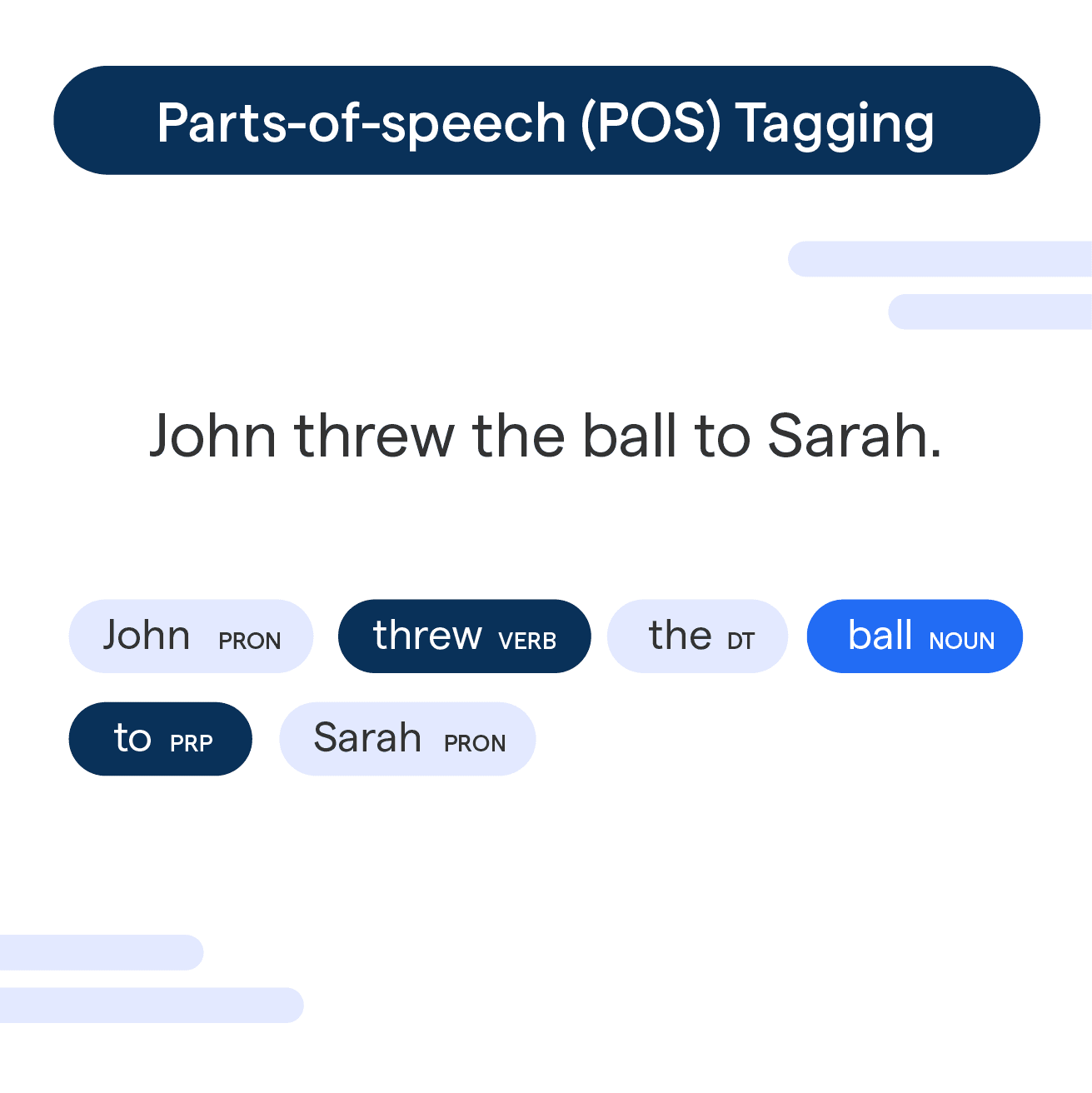What is Parts-of-Speech (POS) Tagging?
Parts-of-speech tagging, or POS tagging, is the process of labeling each word in a sentence with its appropriate part of speech. It's like assigning an identity card to each word telling you what role it plays! Let's look at an example:
"John threw the ball to Sarah."
The POS tagging for this sentence would be:
John (Proper Noun) threw (Verb) the (Determiner) ball (Noun) to (Preposition) Sarah (Proper Noun).
So "John" is labeled as a proper noun, "threw" gets tagged as a verb, "the" is marked as a determiner, and so on. POS tagging helps identify nouns, verbs, adjectives, adverbs and other parts of speech in a piece of text.
This kind of linguistic analysis is super useful for Natural Language Processing tasks like machine translation, speech recognition, and even chatbot development! Knowing the POS of words provides context and helps determine sentence structure. So next time you read a text, imagine little identity cards over each word revealing its role - that's POS tagging!
Parts-of-Speech (POS) Tagging: An Overview
Who uses POS Tagging?
POS Tagging is used by linguists, NLP engineers, data analysts, and researchers across a variety of industries. It's like a secret code that helps us unlock the mysteries of human language.
Why do we need POS Tagging?
We need POS Tagging because it helps us accurately understand the meaning and context of words in a sentence. It's like having a universal translator that can decipher the intricacies of language.
When is POS Tagging used?
POS Tagging is used in a wide range of NLP applications, from chatbots and virtual assistants to search engines and text-to-speech synthesis. It's like the magical ingredient that makes these applications smarter and more human-like.
Where is POS Tagging applied?
POS Tagging is used in a variety of industries and contexts, including social media analytics, academic research, and language teaching and learning. It's like a versatile tool that can be applied wherever language is involved.
How does POS Tagging work?
POS Tagging uses methods and algorithms to analyze a sentence and determine the most probable part of speech for each word. There are several approaches to POS Tagging, including statistical and rule-based methods. It's like having a detective who examines each word to figure out its true identity.
What are the Types of POS Tagging?
In this section, we'll delve into the various types of Part of Speech (POS) tagging methodologies that form an integral part of natural language processing.
Rule-Based POS Tagging
This method employs a set of predefined rules and grammatical patterns. It’s advantageous in its simplicity and precision, but it offers limited flexibility, failing to account for new expressions or language changes.
Stochastic or Probabilistic POS Tagging
Stochastic POS tagging methods, like Hidden Markov Models, calculate the probability of a word being a specific part of speech based on previous words or tags. It’s effective in handling ambiguity but requires appropriate training data for accurate results.
Transformation-Based POS Tagging
This approach, also known as the Brill Tagger, starts with basic rule-based tagging. It then iteratively refines the tagging by examining errors and creating transformation rules to correct them. Efficiency and language independence are its strengths.
Machine Learning-Based POS Tagging
This approach leverages machine learning algorithms, such as Decision Trees or Neural Networks, to classify words into correct POS tags. While powerful, they require high-quality, large-scale annotated data for training.
Hybrid POS Tagging
Hybrid methods combine elements of the approaches mentioned above, seeking to achieve greater accuracy and flexibility. They capitalize on the strengths of different methods while minimizing their individual limitations.
Applications of POS Tagging
In this section, we'll cover the various applications of Part-Of-Speech (POS) Tagging and how it assists in different computational tasks.
Natural Language Processing
POS tagging is fundamental to Natural Language Processing (NLP). It aids in understanding the context and interpreting the semantic meaning of words in a sentence.
Information Extraction
POS tagging plays an integral role in extracting useful and structured information from raw unstructured text, making it instrumental in data mining tasks.
Question Answering Systems
POS tagging helps in discerning the syntactic roles of words in a question, which aids Question Answering (QA) Systems in providing accurate and relevant responses.
Sentiment Analysis
By identifying and classifying words into their respective part of speech, POS tagging aids in sentiment analysis, determining the tone or sentiment behind the text data.
Text-to-Speech Conversion
POS tagging contributes to Text-to-Speech (TTS) systems by providing crucial information about the pronunciation of words based on their positions in the sentence.
Part-Of-Speech tagging is a cornerstone in many language-related fields, significantly contributing to the effectiveness of computations that require language understanding.
What are the challenges of POS Tagging?
In this section, we'll discuss the various challenges that arise while performing Part-of-Speech (POS) tagging, a crucial step in natural language processing.
Ambiguity in Word Meanings
Homonyms and homographs introduce ambiguity in part-of-speech tagging due to the same word having different meanings or functions in different contexts.
Colloquial Language and Slang
Taggers may struggle with accurately identifying and tagging slang, colloquial terms, or phrases that deviate from standard language rules, making the POS tagging process difficult.
Handling Unknown Words
Encountering new words, particularly from technical terms or emerging trends, can be challenging, as the tagger may not have enough context to accurately assign a part-of-speech.
Idiomatic Expressions
Identifying idiomatic expressions can be difficult due to their non-literal meanings, posing a challenge to the part-of-speech tagging process.
Language Variations and Dialects
Different language variations, dialects, and regional expressions can impact the accuracy of part-of-speech tagging by presenting unique grammar structures and word usage.
Frequently Asked Questions (FAQs)

What is POS Tagging and why is it important?
POS Tagging is a technique in NLP that assigns parts of speech to words. It's important because it helps NLP applications understand the meaning and context of words.
How does POS Tagging work?
POS Tagging uses algorithms to analyze sentences and determine the most likely part of speech for each word. It considers context and patterns to make accurate assignments.
What are the challenges in POS Tagging?
One challenge is dealing with words that have multiple possible parts of speech. Another challenge is handling informal or slang language. Context and algorithms help mitigate these challenges.
How is POS Tagging evaluated for accuracy?
POS Tagging is evaluated using metrics like precision, recall, and F1-score. These measures assess the performance and accuracy of the tagging process.
What are the applications of POS Tagging in NLP?
POS Tagging is used in a wide range of applications such as chatbots, virtual assistants, search engines, sentiment analysis, and text categorization. It helps these applications understand and process human language.

